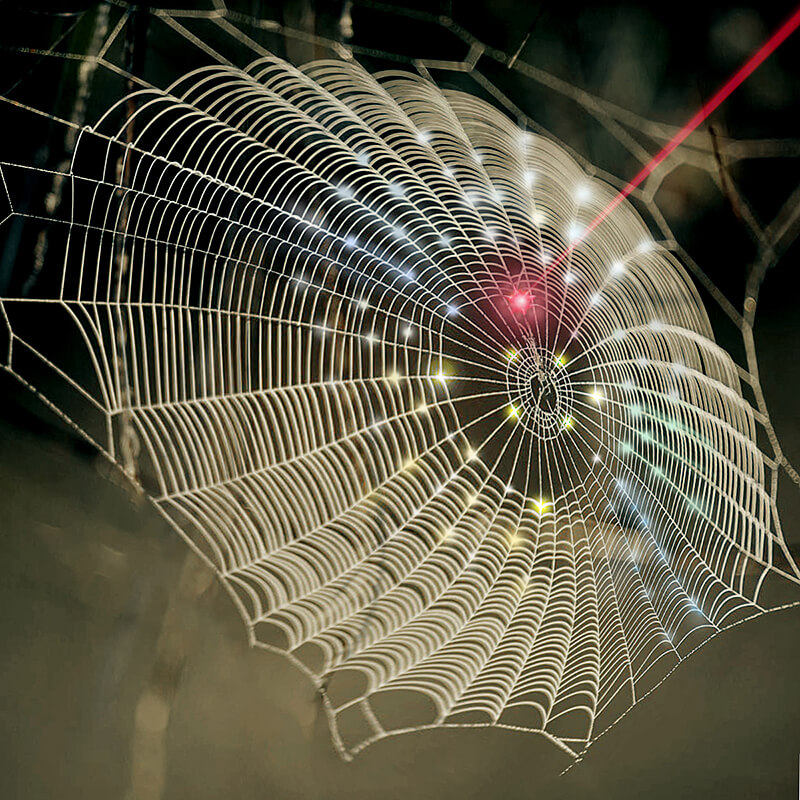October 21, 2020
Innovation spins spider web architecture into 3D imaging technology

A spiderweb-inspired fractal design is used for hemispherical 3D photodetection to replicate the vision system of arthropods. (Sena Huh image)
WEST LAFAYETTE, Ind. – Purdue University innovators are taking cues from nature to develop 3D photodetectors for biomedical imaging.
The Purdue researchers used some architectural features from spider webs to develop the technology. Spider webs typically provide excellent mechanical adaptability and damage-tolerance against various mechanical loads such as storms.
“We employed the unique fractal design of a spider web for the development of deformable and reliable electronics that can seamlessly interface with any 3D curvilinear surface,” said Chi Hwan Lee, a Purdue assistant professor of biomedical engineering and mechanical engineering. “For example, we demonstrated a hemispherical, or dome-shaped, photodetector array that can detect both direction and intensity of incident light at the same time, like the vision system of arthropods such as insects and crustaceans.”
The Purdue technology uses the structural architecture of a spider web that exhibits a repeating pattern. This work is supported by the National Science Foundation (NSF; CMMI-1928784) and the Air Force Research Laboratory (AFRL; S-114-054-002). It is published in Advanced Materials.
Lee said this provides unique capabilities to distribute externally induced stress throughout the threads according to the effective ratio of spiral and radial dimensions and provides greater extensibility to better dissipate force under stretching. Lee said it also can tolerate minor cuts of the threads while maintaining overall strength and function of the entire web architecture.
“The resulting 3D optoelectronic architectures are particularly attractive for photodetection systems that require a large field of view and wide-angle antireflection, which will be useful for many biomedical and military imaging purposes,” said Muhammad Ashraful Alam, the Jai N. Gupta Professor of Electrical and Computer Engineering.
Alam said the work establishes a platform technology that can integrate a fractal web design with system-level hemispherical electronics and sensors, thereby offering several excellent mechanical adaptability and damage-tolerance against various mechanical loads.
“The assembly technique presented in this work enables deploying 2D deformable electronics in 3D architectures, which may foreshadow new opportunities to better advance the field of 3D electronic and optoelectronic devices,” Lee said.
The team is working with the Purdue Research Foundation Office of Technology Commercialization to secure a patent for the technology. For information on licensing opportunities, contact D.H.R. Sarma at OTC at dhrsarma@prf.org and mention track code 2017-LEE-67683.
About Purdue Research Foundation
The Purdue Research Foundation is a private, nonprofit foundation created to advance the mission of Purdue University. Established in 1930, the foundation accepts gifts; administers trusts; funds scholarships and grants; acquires property; protects Purdue's intellectual property; and promotes entrepreneurial activities on behalf of Purdue. The foundation manages the Purdue Foundry, Purdue Office of Technology Commercialization, Purdue Research Park, Purdue Technology Centers and University Development Office. In 2020, the IPWatchdog Institute ranked Purdue third nationally in startup creation and in the top 20 for patents. The foundation received the 2019 Innovation and Economic Prosperity Universities Award for Place from the Association of Public and Land-grant Universities. For more information on licensing a Purdue innovation, contact the Purdue Office of Technology Commercialization at otcip@prf.org. For more information about involvement and investment opportunities in startups based on a Purdue innovation, contact the Purdue Foundry at foundry@prf.org.
About Purdue University
Purdue University is a top public research institution developing practical solutions to today’s toughest challenges. Ranked the No. 5 Most Innovative University in the United States by U.S. News & World Report, Purdue delivers world-changing research and out-of-this-world discovery. Committed to hands-on and online, real-world learning, Purdue offers a transformative education to all. Committed to affordability and accessibility, Purdue has frozen tuition and most fees at 2012-13 levels, enabling more students than ever to graduate debt-free. See how Purdue never stops in the persistent pursuit of the next giant leap at purdue.edu.
Writer: Chris Adam, cladam@prf.org
Sources: Chi Hwan Lee, lee2270@purdue.edu
Muhammad Ashraful Alam, alam@purdue.edu
ABSTRACT
Fractal Web Design of a Hemispherical Photodetector Array with Organic‐Dye‐Sensitized Graphene Hybrid Composites
Eun Kwang Lee, Ratul Kumar Baruah, Jung Woo Leem, Woohyun Park, Bong Hoon Kim, Augustine Urbas, Zahyun Ku, Young L. Kim, Muhammad Ashraful Alam and Chi Hwan Lee
The vision system of arthropods consists of a dense array of individual photodetecting elements across a curvilinear surface. This compound-eye architecture could be a useful model for optoelectronic sensing devices that require a large field of view and high sensitivity to motion. Strategies that aim to mimic the compound-eye architecture involve integrating photodetector pixels with a curved microlens, but their fabrication on the curvilinear surface is challenged by the use of standard microfabrication processes that are traditionally designed for planar, rigid substrates (e.g., Si wafers). Here, we report a fractal web design of hemispherical photodetector array that contains an organic dye-sensitized graphene hybrid composite to serve as an effective photoactive component with enhanced light absorbing capabilities. The device is first fabricated on a planar Si wafer at the microscale and then transferred to transparent hemispherical domes with different curvatures in a deterministic manner. The unique structural property of the fractal web design provides protection of the device from damage by effectively tolerating various external loads. Comprehensive experimental and computational studies reveal the essential design features and optoelectronic properties of the device, followed by the evaluation of its utility in the measurement of both the direction and intensity of incident light.

